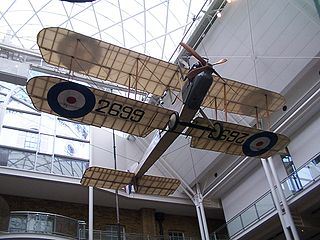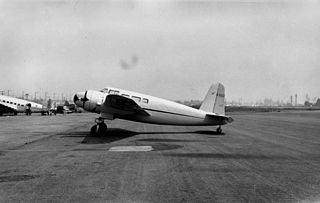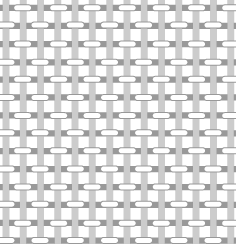
Monocoque, also called structural skin, is a structural system in which loads are supported by an object's external skin, similar to an egg shell. The word monocoque is a French term for "single shell" or "single hull".

The fuselage is an aircraft's main body section. It holds crew, passengers, and cargo. In single-engine aircraft, it will usually contain an engine, as well, although in some amphibious aircraft the single engine is mounted on a pylon attached to the fuselage, which in turn is used as a floating hull. The fuselage also serves to position control and stabilization surfaces in specific relationships to lifting surfaces, which is required for aircraft stability and maneuverability.

Luscombe Aircraft was a United States aircraft manufacturer from 1933 to 1950.

The mechanical structure of an aircraft is known as the airframe. This structure is typically considered to include the fuselage, undercarriage, empennage and wings, and exclude the propulsion system.

Homebuilt aircraft, also known as amateur-built aircraft or kit planes, are constructed by persons for whom this is not a professional activity. These aircraft may be constructed from "scratch", from plans, or from assembly kits.
A geodeticairframe is a type of construction for the airframes of aircraft developed by British aeronautical engineer Barnes Wallis in the 1930s. Earlier, it was used by Prof. Schütte for the Schütte Lanz Airship LS 1 in 1909. It makes use of a space frame formed from a spirally crossing basket-weave of load-bearing members. The principle is that two geodesic arcs can be drawn to intersect on a curving surface in a manner that the torsional load on each cancels out that on the other.

The Curtiss-Wright AT-9 Jeep was a twin-engined advanced trainer aircraft used by the United States during World War II to bridge the gap between single-engined trainers and twin-engined combat aircraft. The AT-9 had a low-wing cantilever monoplane configuration, retractable landing gear and was powered by two Lycoming R-680-9 radial engines.

In mechanical engineering, stressed skin is a type of rigid construction, intermediate between monocoque and a rigid frame with a non-loaded covering. A stressed skin structure has its compression-taking elements localized and its tension-taking elements distributed. Typically, the main frame has rectangular structure and is triangulated by the covering.

The Short Springbok was a two-seat, all-metal reconnaissance biplane produced for the British Air Ministry in the 1920s. Altogether six aircraft of the Springbok design were built but none entered service with the armed forces.

Aircraft dope is a plasticised lacquer that is applied to fabric-covered aircraft. It tightens and stiffens fabric stretched over airframes, which renders them airtight and weatherproof, increasing their durability and lifespan. The technique has been commonly applied to both full-size and flying models of aircraft.

The Fokker V.1 was a small German sesquiplane experimental fighter prototype built in 1916 by the Fokker-Flugzeugwerke. Sporting a parasol wing, it was the first Fokker aircraft purportedly designed by Reinhold Platz—the respective roles played by Fokker himself, Platz, and possibly others in the conceptual design of Fokker airplanes are a matter of dispute among historians—and was an early experiment in cantilever wing construction, eliminating the bracing wires typical of aircraft design at the time, something that had already been achieved with metal materials in Hugo Junkers' own pioneering Junkers J 1 in 1915.

The Bennett Aircraft Corporation Bi-motored Transport Commercial Number One (BTC-1) Executive was a 1930s American eight-seat light transport aircraft built by the Bennett Aircraft Corporation. In the ten-year span of its known life, the Bennett BTC-1 was identified in print by four different names: the Bennett, the Breese Bennett, the Bowlus Bennett and the Globe BTC-1.

The Junkers J 1, nicknamed the Blechesel, was an experimental monoplane aircraft developed by Junkers & Co. It was the world's first all-metal aircraft.
The skin of an aircraft is the outer surface which covers much of its wings and fuselage. The most commonly used materials are aluminum and aluminium alloys with other metals, including zinc, magnesium and copper.

The Schweizer SGU 1-7 is an American Open Class, single-seat, high-wing strut braced glider built by Schweizer Metal Aircraft Company of Elmira, New York.

Madapollam is a soft cotton fabric manufactured from fine yarns with a dense pick laid out in linen weave. Madapollam is used as an embroidery and handkerchief fabric and as a base for fabric printing. The equal warp and weft mean that the tensile strength and shrinkage is the same in any two directions at right angles and that the fabric absorbs liquids such as ink, paint and aircraft dope equally along its X and Y axes.

The Bristol M.R.1 was an experimental biplane with an aluminium monocoque fuselage and metal wings, produced by Bristol during the First World War. Two were built to government order.

Aircraft fabric covering is a term used for both the material used and the process of covering aircraft open structures. It is also used for reinforcing closed plywood structures, the de Havilland Mosquito being an example of this technique, and on the pioneering all-wood monocoque fuselages of certain World War I German aircraft like the LFG Roland C.II, in its wrapped Wickelrumpf plywood strip and fabric covering.

The Douglas XT3D was an American three-seat torpedo bomber biplane developed by the Douglas Aircraft Company to meet a United States Navy requirement.
In aeronautics, bracing comprises additional structural members which stiffen the functional airframe to give it rigidity and strength under load. Bracing may be applied both internally and externally, and may take the form of strut, which act in compression or tension as the need arises, and/or wires, which act only in tension.

















